m (partial revert: not sourced and interrupts flow of sentence) |
(→Sources: +1) |
||
| Line 432: | Line 432: | ||
*{{SW|url=series/the-mandalorian/chapter-8-guide|text="Chapter 8: Redemption" Episode Guide|archivedate=20201030104650}} |
*{{SW|url=series/the-mandalorian/chapter-8-guide|text="Chapter 8: Redemption" Episode Guide|archivedate=20201030104650}} |
||
*{{AltayaCite|Battle of Hoth and the Second Death Star}} |
*{{AltayaCite|Battle of Hoth and the Second Death Star}} |
||
| + | *[[The Art of The Mandalorian (Season One)|''The Art of The Mandalorian'' Season One]] |
||
*''[[Disney Gallery: The Mandalorian: Making of Season Two]]'' |
*''[[Disney Gallery: The Mandalorian: Making of Season Two]]'' |
||
*''[[Star Wars: The Mandalorian: The Ultimate Visual Guide]]'' |
*''[[Star Wars: The Mandalorian: The Ultimate Visual Guide]]'' |
||
Revision as of 00:49, 7 January 2021
| | |
- "The armor I wear is five hundred years old. I reforged it to my liking, but the battles, the history, the blood all lives within it. And the same goes for every Mandalorian."
"This armor is part of our identity. It makes us Mandalorians who we are." - ―Sabine and Alrich Wren
Mandalorian armor referred to the traditional armor worn by the human warrior clans of the planet Mandalore. Common traits included a helmet with a T-shaped visor that concealed their faces, and armaments like whipcord throwers, flamethrowers, and jetpacks.
The Mandalorians' bloody history made their armor an iconic symbol of fear. Mandalorian armor was made from beskar, which was one of the strongest metals in the galaxy. Beskar could protect the wearer from blasters and even lightsabers. The bounty hunter Jango and his cloned son, Boba Fett wore customized Mandalorian armor, which was made with a beskar alloy.
The Arc Pulse Generator, an Imperial superweapon, was capable of superheating the beskar alloy used in Mandalorian armor to incinerate its wearer.
Description
- "With right calibration, a blaster could pass right through Mandalorian armor."
"Impossible. You try that, a Mandalorian would break you in two."
"Funny, that's exactly how the guy who told me died." - ―Two stormtroopers converse five years into the Imperial Era
Generally the armor was made from beskar, a highly durable metal which could repel blaster fire[4] and lightsaber strikes[5] while giving the user maximum protection, although variants made from durasteel and other lesser materials were frequently utilized due to those materials being more common. The helmets had an angled visor, which reflected Mandalorian style, and the unique armor became a symbol of fear across the galaxy as the Mandalorian warriors engaged in numerous wars. Due to the durability of the beskar metal, some armor sets were hundreds of years old, such as in the case of Sabine Wren's armor.[2]
History
Tradition of Mandalore
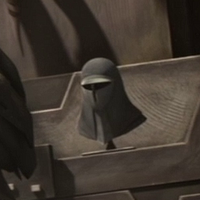
A Neo-Crusader's helmet
The ancient Mandalorian Crusaders wore helmets over cloaks.[6] The Mandalorian Neo-Crusaders also wore helmets.[7] After encountering the Jedi during the early crusades, the Mandalorian-Jedi War began and it was during this period that the Mandalorians created their signature armor, weaponry and fighting style in order to combat the Jedi Knights and their Force abilities.[8]
During time after the Mandalorian Civil War, two styles of Mandalorian armor would emerge—the formidable traditional armor of the warrior clans like Death Watch, and those of the pacifist New Mandalorians.[1] Death Watch's female warriors, the Nite Owls, wore a different set of armor.[9]
The foundling Jango Fett wore the armor type, which had been given to him by the Mandalorians.[10] Prime Minister Almec, however, expressed bewilderment as to how he would have obtained it, decrying Fett as nothing but a common bounty hunter.[1] The Kaminoans who cloned him to create the Grand Army of the Republic took inspiration from his suit for the clone trooper armor.[3]
Clone Wars
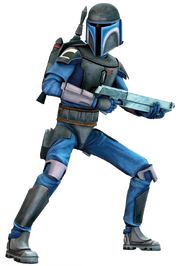
A Mandalorian member of Death Watch
After Fett was killed by Jedi Master Mace Windu during the First Battle of Geonosis, his helmet was used by Boba as a bomb in an attempt on Windu's life.[11] By the Age of the Empire, Boba had inherited his father's armor and rebuilt it in his memory.[12]
The renegade Sith Lord Maul defeated and killed Pre Vizsla and became ruler of Mandalore during the Clone Wars, causing his followers in Death Watch to customize their armor with painted helmets, handprints, and horns resembling their new Dathomirian Zabrak leader.[13]
The Mandalorian Protectors, such as the those who served with Fenn Rau in Skull Squadron wore armor when they fought at the Third Battle of Mygeeto.[14]
Age of the Empire
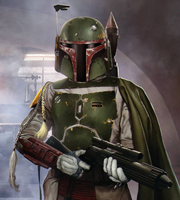
Boba Fett, wearing his Mandalorian armor
Following the end of the Clone Wars, the Protectors continue to wear the armor as part of their arrangement with the Galactic Empire at their encampment on Concord Dawn's third moon.[15] Gar Saxon, acting as the Imperial Viceroy of Mandalore, and the Imperial Super Commandos such as Tristan Wren,[16] wore armor that resembled stormtrooper armor.[17] Members of Clan Wren, such as it's leader, Countess Ursa Wren, wore armor with yellow markings.[16] At some point during his bounty hunting career, Boba Fett began to wear his father's Mandalorian armor.[12]
Sometime after the Battle of Endor, Fett's set of Mandalorian armor ended up in storage in a Jawa sandcrawler on Tatooine. Cobb Vanth, who was on the sandcrawler after the Jawas rescued him from dehydration in the desert, happened upon a crate containing the armor. After trading valuable silicax crystals with the jawas, he attained the armor for his own, and wore it to defend the town of Mos Pelgo.[18]
The pirate Kars Tal-Korla wore a trademark suit of patchwork armor made from Corellian, Imperial trooper, and Mandalorian.[19]
New Republic Era
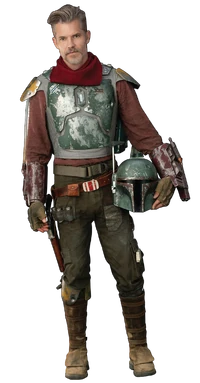
Cobb Vanth came into possession of Boba Fett's armor.
During the New Republic Era, the Mandalorians became rarer to see, after the Great Purge by the Empire against them. During that time the Empire also plundered vast amounts of Beskar from the Mandalorians. The Mandalorians took orphans in as foundlings. One Mandalorian tribe hid in an enclave under Nevarro city on the planet Nevarro. However, after they fought the Bounty Hunters' Guild in the city,[20] an Imperial remnant cracked down on them, killing many. Their armor was piled up in the enclave to be salvaged by the Armorer, one of the only survivors from the tribe. Another survivor, bounty hunter Din Djarin, was given a signet depicting a mudhorn on his armor to symbolize the clan consisting of himself and Grogu.[21]
Seeking out other Mandalorians to help in his quest to bring Grogu to the Jedi, Djarin arrived in the town of Mos Pelgo on Tatooine. There, he encountered Cobb Vanth, who was still wearing Boba Fett's armor to defend the town. As Djarin did not want a non-Mandalorian to wear it, Vanth agreed to give over the armor if the bounty hunter helped kill a greater krayt dragon that had been terrorizing his town. After the creature's death, Vanth stayed true to his word and gave over the armor, parting on good terms with Djarin. Unknown to the bounty hunter, as he left the town, he was being watched by the still-alive Fett.[18]
After successfully helping a passenger and her eggs reach Trask and reunite with her husband, Djarin was recruited by Bo-Katan Kryze, Axe Woves, and Koska Reeves to help them raid a Gozanti-class cruiser belonging to the remnant in order to capture some weapons being exported from the black market port. The quartet of Mandalorians fought through several units of stormtroopers to reach the cargo hold.[22]
The quartet were temporarily stopped by a remnant officer who trapped them in the cargo control area. The officer and a group of stormtroopers that accompanied him in defending the hold were jettisoned. After Kryze revealed to the captain that he had captured the cargo hold, the captain stated that even if they jettisoned the crates of cargo, they would comb the area and kill them. Kryze revealed that her true objective was to fully capture the ship and storm the bridge even to the distraught and shock of Djarin. Djarin eventually agreed to help Kryze storm the bridge and fully capture the ship, in return Kyrze would reveal the whereabouts of a Jedi.[22]
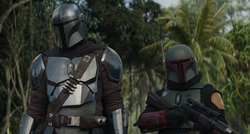
Din Djarin and Boba Fett on Morak.
Djarin and Boba Fett would come face-to-face on Tython, when Fett would employ the skills of sharpshooter Fennec Shand, whom Fett had saved on Tatooine. Shand, having Grogu in her sights, would stand down and in exchange Djarin would remove his jetpack. Fett would then demanded his armor be returned to him, having tracked it and the Mandalorian to the inner core planet. Djarin refused, stating the armor was looted in the Great Purge and belonged to the Mandalorian people. Fett would argue, however, that the armor had in fact been passed down to him from his father, who had been gifted it by one of Djarin's forebearers. The arrival of Imperial remnants would cut the conversation short, with Fett offering to trade the return of his armor in exchange for guaranteeing both Grogu and Djarin's safety. During the ensuing conflict, Fett would take his armor from Djarin's Razor Crest, while Shand and Djarin continued to fight the reinforced Imperial remnants. Late into the skirmish, Djarin and Shand would find themselves surrounded, outmanned, and outgunned. Djarin would use his beskar-clad body to prevent Shand from being hit by Imperial blaster fire while the two returned fire. Fett would drop two explosives on the battlefield from above, then display its capabilities by singlehandedly eliminating an entire platoon of stormtroopers, as well as two Imperial troop dropships. Fett utilized an array of offensive weapons including a wrist blaster, micro rockets, kneepad rocket darts, and a jetpack-launched missile. Afterward, Fett would show Djarin his chain code, which proved that the ownership of the armor had indeed been that of a Mandalorian foundling; Boba's father, Jango Fett. Pledging to assist the Mandalorian in Grogu's rescue as part of their deal, Fett, Djarin, and Shand would depart for Navarro on Slave I.[10]
Design
- "My armor is like my second skin. I'm being serious: sometimes I totally forget I even have it on and I fall asleep in it."
- ―Sabine Wren
Traditional Mandalorian armor consisted of a helmet, shoulder pauldrons, vambraces, breastplate, codpiece, knee-pads, thigh and shin guards clasped over a body stocking. Mandalorian helmets often had a macrobinocular viewplate, tactical heads-up displays,[23] a comlink, and an antenna tipped with a rangefinder that could be pulled over the viewplate to enhance imagery.[3] Sabine Wren programmed a holo-imager in her helmet's rangefinder to take snapshots.[24] They wore magnetized shoes.[23]
Mandalorian vambraces were computer-controlled tools bristling with weaponry,[24] designed to combat the abilities of a Jedi.[25] They potentially included:
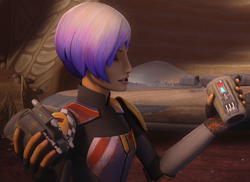
Sabine Wren holds up a pair of Mandalorian Vambraces.
- Flamethrowers[3][9][26]
- Wrist lasers[3][13]
- Wrist rockets[3][9]
- Whipcord throwers[3][13]
- Projectile buzzsaws[26]
- Shield emitters[13]
- Retractable wrist blades[27][9]
- Kamino saberdarts[28]
- Grappling lines[29]
- Paralyzing darts[29]
- Repulsors[29]
- Whistling birds[30]
The Mandalorians used many models of jetpacks, including the Z-6 and JT-12, to increase maneuverability in combat as well as fly. These were often tipped with a launcher that were used to fire anti-vehicle homing missiles. However, they could also be used to fire a grappling hook linked to an internal winch. Gyro-stabilizers made it easy to maneuver in the air, and were capable of both short jumps and long-distance flight.[5]
Appearances
Non-canon appearances
- Disney Infinity 3.0
- Star Wars Epic Yarns: The Empire Strikes Back
- Angry Birds Star Wars II
- Star Wars: Galaxy of Heroes
 LEGO Star Wars: The Freemaker Adventures — "Race on Tatooine"
LEGO Star Wars: The Freemaker Adventures — "Race on Tatooine" LEGO Star Wars: Droid Tales — "Exit from Endor" (In flashback(s))
LEGO Star Wars: Droid Tales — "Exit from Endor" (In flashback(s)) LEGO Star Wars: Droid Tales — "Flight of the Falcon" (In flashback(s))
LEGO Star Wars: Droid Tales — "Flight of the Falcon" (In flashback(s)) LEGO Star Wars: Droid Tales — "Mission to Mos Eisley" (In flashback(s))
LEGO Star Wars: Droid Tales — "Mission to Mos Eisley" (In flashback(s)) LEGO Star Wars: Droid Tales — "Gambit on Geonosis" (In flashback(s))
LEGO Star Wars: Droid Tales — "Gambit on Geonosis" (In flashback(s))- LEGO Star Wars: The Force Awakens
Sources
Notes and references
- ↑ 1.0 1.1 1.2
 Star Wars: The Clone Wars — "The Mandalore Plot"
Star Wars: The Clone Wars — "The Mandalore Plot"
- ↑ 2.0 2.1 Star Wars Rebels: Heroes of Mandalore
- ↑ 3.0 3.1 3.2 3.3 3.4 3.5 3.6 Ultimate Star Wars
- ↑ The Mandalorian
- ↑ 5.0 5.1 Ultimate Star Wars, New Edition
- ↑
 Shades of Reason Trivia Gallery on StarWars.com (backup link) (Slides 3 and 4)
Shades of Reason Trivia Gallery on StarWars.com (backup link) (Slides 3 and 4)
- ↑
 Star Wars: The Clone Wars — "Wookiee Hunt"
Star Wars: The Clone Wars — "Wookiee Hunt"
- ↑ Star Wars Rebels Showrunner Explains Major Knight of the Old Republic Reference by Lucas Siegel, published by ComicBook.com on comicbook.com (archived from the original on February 20, 2017)
- ↑ 9.0 9.1 9.2 9.3
 Star Wars: The Clone Wars — "A Friend in Need"
Star Wars: The Clone Wars — "A Friend in Need"
- ↑ 10.0 10.1
 The Mandalorian — "Chapter 14: The Tragedy"
The Mandalorian — "Chapter 14: The Tragedy"
- ↑
 Star Wars: The Clone Wars — "R2 Come Home"
Star Wars: The Clone Wars — "R2 Come Home"
- ↑ 12.0 12.1 Star Wars: The Complete Visual Dictionary, New Edition
- ↑ 13.0 13.1 13.2 13.3
 Star Wars: The Clone Wars — "The Lawless"
Star Wars: The Clone Wars — "The Lawless"
- ↑ Kanan 10
- ↑
 Star Wars Rebels — "The Protector of Concord Dawn"
Star Wars Rebels — "The Protector of Concord Dawn"
- ↑ 16.0 16.1
 Star Wars Rebels — "Legacy of Mandalore"
Star Wars Rebels — "Legacy of Mandalore"
- ↑
 Star Wars Rebels — "Imperial Supercommandos"
Star Wars Rebels — "Imperial Supercommandos"
- ↑ 18.0 18.1
 The Mandalorian — "Chapter 9: The Marshal"
The Mandalorian — "Chapter 9: The Marshal"
- ↑ Aftermath
- ↑
 The Mandalorian — "Chapter 3: The Sin"
The Mandalorian — "Chapter 3: The Sin"
- ↑
 The Mandalorian — "Chapter 8: Redemption"
The Mandalorian — "Chapter 8: Redemption"
- ↑ 22.0 22.1
 The Mandalorian — "Chapter 11: The Heiress"
The Mandalorian — "Chapter 11: The Heiress"
- ↑ 23.0 23.1 Star Wars: Absolutely Everything You Need to Know
- ↑ 24.0 24.1 Sabine My Rebel Sketchbook
- ↑
 Mandalorian Vambraces in the Databank (backup link)
Mandalorian Vambraces in the Databank (backup link)
- ↑ 26.0 26.1
 Star Wars: The Clone Wars — "Shades of Reason"
Star Wars: The Clone Wars — "Shades of Reason"
- ↑
 Jango Fett in the Databank (backup link)
Jango Fett in the Databank (backup link)
- ↑ Star Wars: Episode II Attack of the Clones
- ↑ 29.0 29.1 29.2
 Star Wars Rebels — "Trials of the Darksaber"
Star Wars Rebels — "Trials of the Darksaber"
- ↑
 The Mandalorian — "Chapter 3: The Sin"
The Mandalorian — "Chapter 3: The Sin"

